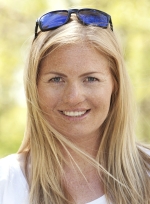Previous events - Page 231
Anders Tranberg, University of Stavanger
The asymmetry between matter and antimatter is still an unsolved mystery of astroparticle physics. Presumably, the asymmetry was generated during a strong phase transition at or before the electroweak symmetry breaking transition in the Early Universe. Electroweak baryogenesis as a scenario has a long and illustrious history of trial and not-quite-success. I will present a related, competing model ("Cold" electroweak baryogenesis), and demonstrate how one may numerically compute and actual number for the generated asymmetry from first principles.
(The slides are now available)
The 4th Norwegian Microbiology Meeting (NoMi-16) will be held 13-15. April 2016 at Quality Hotel & Resort in Sarpsborg.
Synergistic induction of macrophage tumoricidal activity
Adriana Lopes dos Santos, Post Doc, Station Biologique, Roscoff, France
By Mike Benton (Note the time and venue!)
Kristine Beate Walhovd, Professor - Department of Psychology
This Friday the 8th of April we will discuss a paper by Mueller and Newman (2005): "The innovation triad: an EvoDevo agenda".
Hope to see you there!
Jørgen Vold Rennemo (Oxford) gives the Seminar in Algebra and Algebraic Geometry:
K3 surfaces seminar: The moduli spaces of polarized K3 surfaces
Since 2010, Norsonic has in collaboration with Squarehead been selling acoustic camera for the commercial market. But who buys it, what is it used for, and what trends can we see in the future for beamforming systems?
Jørgen Grythe at Norsonic will try to address these points including a presentation of their range of products in beamforming, with a live demonstration of one of their acoustic cameras. Join this presentation to see what the mathematical equations governing array signal processing mean in the physical world, and the chance to get your hands on an acoustic camera to try it yourself.
This thursday, at the Speciation Journal Club, we will discuss a paper on Genomic introgression in sticklebacks by Yoshida et al. 2016 (Ecology and Evolution)
Abstract: There are many interesting examples of groups acting on trees, arising in various fields (e.g. combinatorial group theory, number theory, geometry). When a group acts on a tree, it necessarily also acts on the boundary of the tree, a (totally disconnected) compact Hausdorff space. The C*-algebras obtained from the crossed product construction include many fundamental examples. I will describe methods for analyzing such crossed products, developed in joint work with Nathan Brownlowe, Alex Mundey, David Pask and Anne Thomas.
Late Lunch Talk by Mhairi Alexander, University of the West of Scotland, UK
Manuela Zucknick (Dept. of Biostatistics, UiO) will give a seminar in the lunch area, 8th floor Niels Henrik Abels hus at 14:15.
Nanoparticle delivery of anti-tuberculosis drugs
Formulation and testing of clofazimine containing nanoparticles using a zebrafish embryo tuberculosis model
Welcome to the Seminar on Permafrost and Climate at the Section for Geography and Hydrology, Department of Geosciences, UiO.
Kjersti Gisnås at the Department of Geosciences will be defending her dissertation: Permafrost modelling over different scales in arctic and high-mountain environments
Doctoral candidate Kjersti Gisnås at the Department of Geosciences will give a trial lecture on the given topic: The role of permafrost in the Earth's climate system
Aimee A. Norton, Stanford University
Ricardo Gafeira (Max Planck Institute for Solar System Research)
This Friday the 1st of April we will discuss a paper by Thurman and Barrett (2016): "The genetic consequences of selection in natural populations." Hope to see you there!
Ultrastructural characterization of Francisella tularensis subspecies novicida intracellular life cycle in macrophages. Study of bacterial adherence, phagosome maturation and phagosomal escape.
Arvid Siqveland (HBV), gives the Seminar in Algebra and Algebraic Geometry:
K3 surfaces seminar: Endomorphism fields and Mumford–Tate groups II
Traditional population models are often limited to the female half of the population, but acknowledgement of the importance of males is spreading. There are fundamental differences between male and female demographies, and these differences can strongly affect population dynamics and provide important insights into the evolution of life histories.
In this upcoming session, we will be discussing a recent paper dealing with sex-specific demography and its abilities to inform life history theory:
http://www.nature.com/nature/journal/v526/n7572/abs/nature14968.html
Upcoming short presentation from MSc/PhD students in meteorology and oceanography:
Speaker: Ada Gjermundsen
Title: On the mean position of the Inter-Tropical Convergence Zone
Supervisor: Joe Lacasce
Parampreet Walia, FI
Advancements in experiments for unveiling the nature of Dark Matter (DM) call for more accurate predictions from theorists. Thus a lot of recent interest has developed in calculating higher order corrections to DM annihilation and scattering processes.
Typical Majorana WIMP annihilation to fermions is helicity suppressed. But emission of an extra gauge boson can lift this suppression. Electroweak bremsstrahlung has been studied in much detail earlier, but surprisingly not equal attention has been given to gluon bremsstrahlung.
The major difference between the two cases comes from the fact that quarks and gluons fragment to form hadrons. Computing the spectrum from model to model basis is computationally expensive. I will present a computation friendly approach, which agrees with the real spectrum to a very high accuracy. And then in the end, I would also discuss the impact of QCD corrections on relic density calculations.
(The slides are now available)




